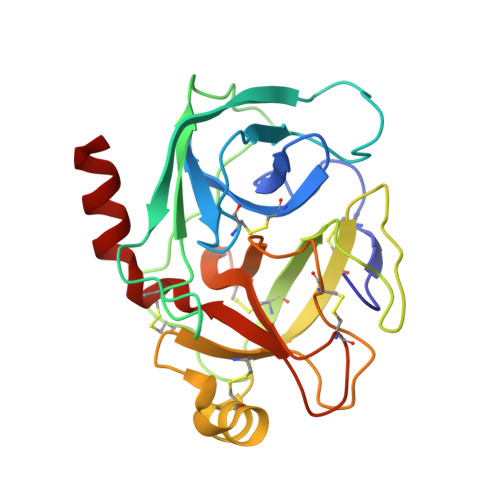Structure of an acyl-enzyme intermediate during catalysis: (guanidinobenzoyl)trypsin.
Mangel, W.F., Singer, P.T., Cyr, D.M., Umland, T.C., Toledo, D.L., Stroud, R.M., Pflugrath, J.W., Sweet, R.M.(1990) Biochemistry 29: 8351-8357
- PubMed: 2252895
- DOI: https://doi.org/10.1021/bi00488a022
- Primary Citation of Related Structures:
1GBT - PubMed Abstract:
The crystal and molecular structure of trypsin at a transiently stable intermediate step during catalysis has been determined by X-ray diffraction methods. Bovine trypsin cleaved the substrate p-nitrophenyl p-guanidinobenzoate during crystallization under conditions in which the acyl-enzyme intermediate, (guanidinobenzoyl)trypsin, was stable. Orthorhombic crystals formed in space group P2(1)2(1)2(1), with a = 63.74, b = 63.54, and c = 68.93 A. This is a crystal form of bovine trypsin for which a molecular structure has not been reported. Diffraction data were measured with a FAST (Enraf Nonius) diffractometer. The structure was refined to a crystallographic residual of R = 0.16 for data in the resolution range 7.0-2.0 A. The refined model of (guanidinobenzoyl)trypsin provides insight into the structural basis for its slow rate of deacylation, which in solution at 25 degrees C and pH 7.4 exhibits a t1/2 of 12 h. In addition to the rotation of the Ser-195 hydroxyl away from His-157, C beta of Ser-195 moves 0.7 A toward Asp-189 at the bottom of the active site, with respect to the native structure. This allows formation of energetically favorable H bonds and an ion pair between the carboxylate of Asp-189 and the guanidino group of the substrate. This movement is dictated by the rigidity of the aromatic ring in guanidinobenzoate--model-building indicates that this should not occur when arginine, with its more flexible aliphatic backbone, forms the ester bond with Ser-195. As a consequence, highly ordered water molecules in the active site are no longer close enough to the scissile ester bond to serve as potential nucleophiles for hydrolysis.(ABSTRACT TRUNCATED AT 250 WORDS)
- Biology Department, Brookhaven National Laboratory, Upton, New York 11973.
Organizational Affiliation:



















